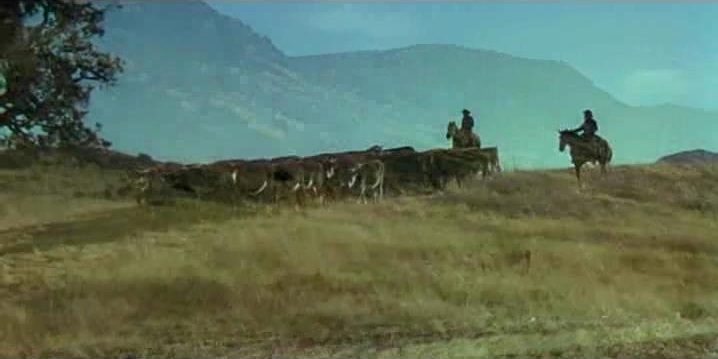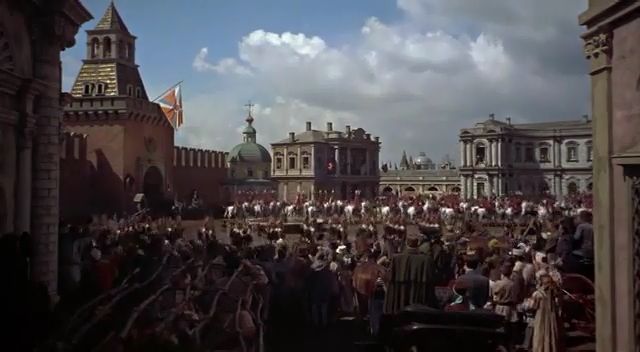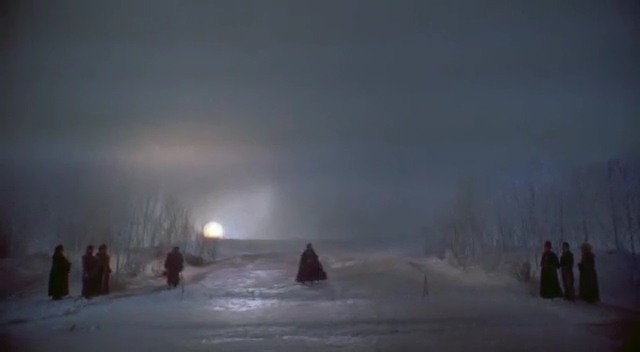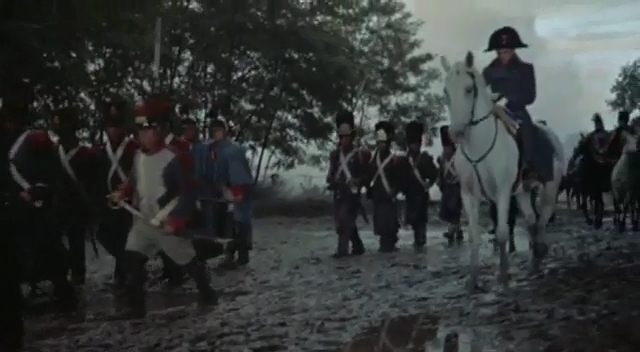The
Big Parade
War fever,
patriotism. A riveter, a Bowery barman, and a rich kid enlist.
It was two and a
half hours long when Variety praised it, time has reduced its fame and
duration.
Before the action,
and for half its present length, a great service comedy.
A bayonet advance through the woods, snipers in
trees, machine-gun emplacements, then the open bare field of the trench
fighting.
The whole war in a single night. Return of the
soldier (Renoir has him in The River).
Attenborough has the long line of vehicles in A
Bridge Too Far, Donald Sutherland borrows Karl Dane as Slim for
Aldrich’s The Dirty Dozen, to name a couple of derivations (Altman
remembers “a helluva army” in MASH).
The credited score by Dr. William Axt is obviously to
be preferred.
The Crowd
Nowadays, played
too fast and with a false orchestral score, the film’s slim chances are
what they always were, Variety hated it, the New York Times found
it sympathetic.
The sharpest
analysis comes from Preston Sturges, who makes Sullivan’s Travels
a critique with reference to Vidor’s revelation. Then there is
Cromwell’s Made for Each Other or Stevens’ Penny Serenade,
followed by many others. Vidor’s unstinting melancholy, tied to epic
views of New York by day or Coney Island by night and a certain comic persona
very characteristic, is all the backdrop to an initiation so abstruse that few
there are who can know it, so he shows what a loss there is in prizes rather
brusquely, and then as abstractly and remotely as he can arrange it in the
final scene, what the real rewards are.
The Patsy
Such a doll (Une Gamine charmante
as it’s given in French), her mother is Marie Dressler.
Can’t get a
tumble, Ma’s favorite has that coming and going, Pa’s favorite
acquires a personality and when that fails, Pa puts his foot down.
Cinderella
“for a rainy afternoon,” Mordaunt Hall
said in his New York Times review,
very funny, “the audience was frequently thrown into gales of
laughter.”
Variety
agreed, “a dandy laugh picture”.
Punch
(cited by Halliwell), “Filmland’s
Funniest Female.”
Not So Dumb
“By a
process of reduction and illumination,” Connelly & Kaufman on the
screen.
A weekend salon
out West, a rich man, a scenarist, the boss in a prospective merger along with
his young wife and her stepdaughter.
Million-dollar
gags are sometimes coupled in sequence, twenty-four of them at least, possibly
a hundred.
Piles of
ignorance and insanity are displayed, a happy dénouement works out the title,
describing a Mrs. Malaprop of our time.
Street Scene
Elmer
Rice’s screenplay offers an enervating New York heat wave as a sort of
laboratory for the study of the nerve-shattering effects of city life,
Vidor’s establishment of this with a montage and crane shot is exemplary.
The whole film’s technical wizardry is uncanny in itself, but for 1931 is
almost beyond belief, years before Dead
End and decades before The
Man with the Golden Arm.
Our Daily Bread
Vidor’s
dramatic style has been ignored for the splash and pace of his irrigation
scenes. Andre Sennwald in the New York Times was pressed by his deadline
and could not spend the time needed to read the language. This remarkably
intimate and immediate constructive sense is really neither compressed nor
elliptical, but it does account for a persistent report that the film was
shortened by ten minutes after its first showing in Chicago. Vidor could have
dilated another ten or twenty or fifty minutes and added nothing, the work is
very fast and pushes dramatic elements in extreme abutment so that the image
exists that carries the scene and establishes the discourse.
So much matter is
conveyed in the seventy present minutes, and the film has lain so long under
the misapprehension even of critics who, like Sennwald, regard it as beyond
praise, that it is necessary to isolate major and minor themes and see the
action of all parts and not merely those the critic agrees with.
Louie, the wanted
criminal on the farm, turns himself in to save it with the reward. He asks the
Minnesotan Swede, Chris, who refuses. He asks the New York blonde, Sally, who
agrees. This is the Whitman proposal that is close to the center of the film
and reflects its main action. Comradeship is only half the principle of
democracy, inspiration of love is the other. Cummings has his
“kumrads” (“they do not know how to love”) to express a
one-sided proposition.
So, while Mary
Sims is the central image of farm and earth, only by leaving with Sally does
John Sims hear “the old powerhouse” and return to dig the
irrigation ditch.
That’s
sufficiently clear, and for the better part of a century critics have spoken of
that ditch. The direct influence is on Ivens’ The Spanish Earth
(and the roadmending sequence in Rosenberg’s Cool Hand Luke). A
dubious print suggests a shadow forming a cross with the first sprouting furrow
that would anticipate both the final image of Ray’s King of Kings
and the miracle in Roeg’s Cold Heaven. A shot of the first-chair
violinist gives Jewison’s Fiddler on the Roof, John and Sally
figure together in Capra’s It’s a Wonderful Life.
Vidor has very
astutely observed his drama, which is partly that of rural and small-town life
after The Crowd, his style serves him to convey it directly.
Mary’s “can I get you anything” as John restlessly prepares
to leave is one of the countless examples of the apposite technique.
Stella Dallas
Lang’s
mediatrix, not Stella but Laurel Dallas, after a fashion. Above and below are
stable, immutable but for accidents such as the senior Dallas’s suicide
and young Stella’s fleeting craze for the social whirl. Two intermediary
zones define conflict in the itching powder scene aboard the train, these are
prurience and censoriousness.
Cassavetes in Love
Streams supplies all the critique that shows a complete analysis.
The Citadel
Of all films, one
most vital for critics to understand because the current of film criticism is
an open sewer only the miracle of Elisha can avert, and then it is a clique and
a charlatanry that costs your right arm to marry, finally a sham and the shadow
of a profession.
Northwest Passage
The significance
is “no royal road”. At its center a study of melancholia (Konkapot
disheartened), at the periphery a much more entailed look at various academic
and legalistic problems, first and foremost an account of the raid on St.
Francis even before Thirty Seconds Over Tokyo.
Vidor is well
ahead of everything else, as is his wont, fifteen or twenty years in style and
technique. So much has been observed, the absolute value of his treatment was
noted at once. Nabokov’s artist was a gorilla who “drew the bars of
his cage”, Vidor dispels the notion entirely by the most dogged effort,
and if Fuller pays homage to Rogers’ Rangers in Merrill’s
Marauders, Huston in Report from the Aleutians gives evidence as
well.
The fine point is
personal initiative threatened by Crown or hostilities in the French and Indian
War, a clear-eyed and sanguine grasp of the situation.
The Fountainhead
Vidor shows his
hand at the quarry, but the lightning strikes at the redesigning of Cortlandt
Homes, insofar as this type of travesty is a common sight fifty years after, as
often as not brought about by remodeling
an existing building.
Whatever is
entailed in the great work is symbolized, and above all the futility of certain
received notions built on sand that are simply refuted by the plain sight of a
competent building.
Those who are led
by the nose or lead others that way are empty shells, there is nothing to
contain that windy bombast of theirs, “form follows function”.
Gary
Cooper’s inflections give such a convincing explication of Frank Lloyd
Wright without any seeming effort that the case for the film is as
self-evident as the architectural projects shown, that often come close to his
work.
The New York
Times review by “dear, dimwitted Bosley” is a real prize
culminating in his parenthetical comment on the critic Toohey, “a
character which carries fantasy to the extreme.”
Beyond the Forest
Beyond the Forest is how Madame Bovary turned
into Who’s Afraid of Virginia
Woolf?, a close study repaid with interest.
The inner line of
an American parody, from Patrick Henry speeches against small-town life to a
Boston Tea Party with a divorce lawyer, is a vast course of amusement.
The great calming
effect of the structure is deliberate and mainstaying, the tale of death by poshlust has a magnificent score by Max
Steiner.
Man Without a Star

Wyoming by way of
Kansas City. How to ride the rails (Emperor of the North, dir. Robert
Aldrich), what to do when you get there, how to wear an Army Stetson flat.
Big spread, open
range, little spreads. The man from the East who has it indoors (The ‘Maggie’, dir. Alexander
Mackendrick).
Title song
(Frankie Laine), a parlous position, cp. The Tin Star
(dir. Anthony Mann) or Lawman (dir.
Michael Winner).
No fixed star is
the meaning, only a loathing for Texas barbed wire (Lonely Are the Brave, dir. David Miller), a position and no
position. The lady owner, no absentee. By stern
degrees, then, to the elemental Western, The
Sea of Grass (dir. Elia Kazan) or The
Big Trees (dir. Felix E. Feist), cp. Forty
Guns (dir. Samuel Fuller).
A.W. of the New York Times, “not the greatest
Western to emerge from the Hollywood manufactories.” Variety, “basic western... writing
variations keep it fresh and the action high”. Dave Kehr
(Chicago Reader), “sexually
askew... a mad film, of harsh Technicolor and spatially impossible camera
angles... unlimited leeway”. Tom Milne (Time Out), “fine, edgy Western.” Halliwell’s Film Guide,
“conventional but entertaining”.
Elemental as a
poem by Robert Frost, and quite as much fun. The title
character, no Bonaparte he (cp. the director’s War and Peace).
War and Peace

“It’s
so unfair,” says frolicsome Natasha, “men are the only people permitted
to have any fun.” And a moment later, sad, “all
those handsome young men marching away to fight—to be killed!”
And thus in five minutes
the work is stated as a poem, starting with the ambivalent Napoleon of Sacha
Guitry, depending on the point of view. A
Tale of Two Cities (dir. Jack Conway or Ralph Thomas) for drunken Pierre (cp. Great Catherine,
dir. Gordon Flemyng). The youthful outlook of Dmytryk’s Raintree County. Homolka as Kotuzov (cp. Billion Dollar Brain, dir. Ken Russell),
the defeat at Austerlitz.
“Men like Dolokhov are only good for wars. In
between wars, they ought to be locked up in cages.”
“Well, I found
glory, I stopped the retreat of a hundred men for five minutes, I was left for dead in a
lost battlefield in a lost war.”
The carriage at night
that drives on past in Madame Bovary
(dir. Vincente Minnelli or Claude Chabrol) and The Heiress (dir. William Wyler), with a
difference. The Battle of Borodino
from The Birth of a Nation (dir. D.W.
Griffith) to Love and Death (dir. Woody
Allen), with a cue from Olivier’s Henry
V for the French emperor’s tent beforehand, a notable memory of The Big Parade and Our Daily Bread in the infantry advance to steady drums, met by
artillery at close quarters answered again with a full-tilt cavalry charge.

“There is
no-one, Sire. The city is empty, half of it on fire.
There is no government. No-one to surrender to you.” The extraordinary stretto
of the final third begins on Fleming’s Gone with the Wind and Wyler’s Jezebel and Borzage’s A Farewell to Arms and Wyler’s Mrs.
Miniver, continuing in Wyler’s Ben-Hur and
Ford’s Cheyenne Autumn and
McLaglen’s Shenandoah and Penn’s
Little Big Man and Roeg’s Cold Heaven.
Screenplay
Boland-Westerby-Vidor-Camerini-De Concini-Perilli,
cinematography Jack Cardiff (second unit Aldo Tonti),
score Nino Rota (conductor Franco Ferrara). A feeling
for Russian painters, a close study for David Lean (Doctor Zhivago) in turn.
Bosley Crowther of the New
York Times, “big and beautifully photographed spectacle.” Variety, “three-and-a-half hours
of vivid cinematic magic.” Tom Milne (Time Out), “essentially hollow”. Leonard Maltin, “overlong,
oversimplified... clumsy script... some profound miscasting.”
Adrian Turner (Radio Times), “as
a spectacle, it’s still impressively humane, though not particularly
Russian, and the casting is decidedly odd.” Film4, “halfway decent movie”. Catholic News Service Media Review Office, “episodic”. Hal Erickson (All
Movie Guide), “a commendable attempt”.
Halliwell’s Film Guide, “the
human side drags a little,” citing Philip T. Hartung
of Commonweal, “pictures in an
art gallery” (Rota echoes Mussorgsky at Borodino).

Solomon and Sheba
The main
character is God, who shapes these events. The screenplay analyzes the story in
three main aspects, the political alliances against Israel (Moab, Chaldea and
Sheba combine with Egypt for a surprise attack), an expanded rendition of the
accounts concerning the Queen of Sheba with a consideration of King
Solomon’s error, and lastly a rendering of the whole thing as a marriage
parable.
A gong is heard
when Sheba is to perform her devotions. She has just closed the curtains in her
quarters at Jerusalem, because “my people would stay and stare at you,
the fabled Solomon,” to which the king replies, “the way I stare at
you?” Then the gong, she’s wearing a silver gown, it’s a gag
from Jet Pilot and is repeated later as she’s standing in a
doorway onto the blue, in a white gown with her back to the camera.
She attends his
court of law where the case of the two mothers is decided. The canticle is
spoken to her in a small boat amid overhanging foliage. A reflection of
DeMille’s The Ten Commandments inheres in her desire to leave the
kingdom so as to carry out her pagan ritual. She is allowed to stay.
Victory is won
when God strikes down the idol, smashes the temple, and pronounces against
Solomon. “I have betrayed a great man who trusted me, who loved me beyond
all else,” says Sheba.
Nathan breaks the
symbol of unity, twelve jewels on a golden tablet. “That which has been
done is that which shall be done,” muses Solomon, “all is
vanity.”
Adonijah scurries
to Egypt for the throne. “All Israel knows,” Solomon observes,
“that God has abandoned the son of David.” Sheba prays to God on
the ruins of the temple, adhering to the covenant. Solomon wakes up in the
night with an inspiration, his vanished armies rally to him. Their shields are
“burnished like mirrors” to reflect the sunrise and blind the
Egyptians, who fall into a deep gulch.
Adonijah is
slain, Sheba is carried unconscious in the arms of Solomon before the ark,
where God speaks and heals her after the people have stoned her at
Adonijah’s command, part of his deal with Egypt. “Now you will be
Queen of Israel,” Solomon says, “and our son shall rule after
me.” No, she counters, and they entreat God to keep faith between them as
they part.
Henry
King’s David and Bathsheba is a very close influence, and Ben-Hur
is evoked at several points (the low cave where the lovers repair before the
lightning, the Egyptian chariots clashing hubs in the battle, the healing).
There is a subtle foretaste of Fellini’s La Dolce Vita in
Abishag’s prayer as well.
Naturally, so
vast and complex a structure requires a detailed commentary. Joab and a
confederate land on Solomon’s terrace like two ninjas in
Peckinpah’s The Killer Elite. Solomon counters the prophets like
King’s David, “my ears are closed to cackling priests and mumbling
old men, I will show you I am king in Israel.” The temple, an
impressive edifice, is blasted like City Hall in Byron Haskin’s The
War of the Worlds.
The performances
are in the rhetorical style, leaving Gina Lollobrigida a superb opening for
“is he—among the dead?” after the rout of the Israelites, and
making the single finest shot not the angled view of soldiers in their ranks
with shields on a rise, nor a medium long shot of the battle in full swing, but
one of her in light blue walking at an angle from the ark over the rubble and
out of the temple.
So close is the
identification with The Ten Commandments that Yul Brynner has the line,
“as it is written, so let it be done.” George Sanders as warlike
Adonijah is a night at the Old Vic. Finlay Currie as David mimes extremity, the
two mothers are excellently well-played.
Adonijah and
Solomon are “my two halves,” says King David, “the soldier
and the poet.” The one looks down on the other as “a weaver of words”
and “a hypocrite,” and forfeits the throne by anticipation, chafing
under the constraints of a defensive posture. Altman’s Countdown
has a similar equipoise between the civil and the military, resolved
inscrutably.
Reverberations
resound. Paul Newman’s Harry and Son has a parrot taught by Joanne
Woodward like the one Lollobrigida toys with during her sojourn in Egypt,
proposing to “teach Pharaoh too” when he complains.
Wisdom, says
Solomon, resides in determining what is true and what is false. Sheba confesses,
“my love is not a lie.”